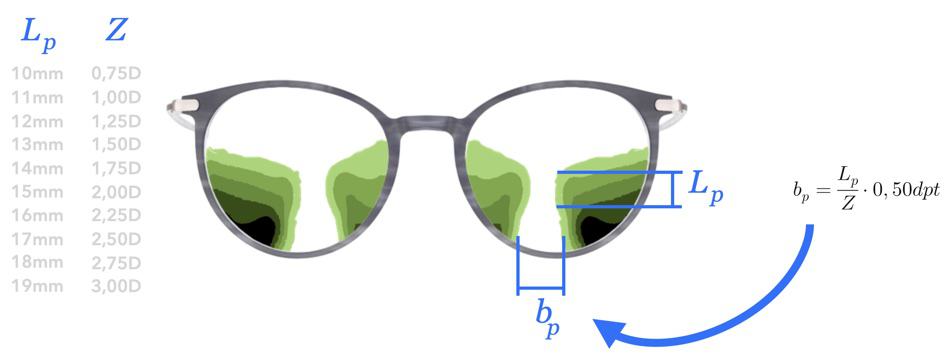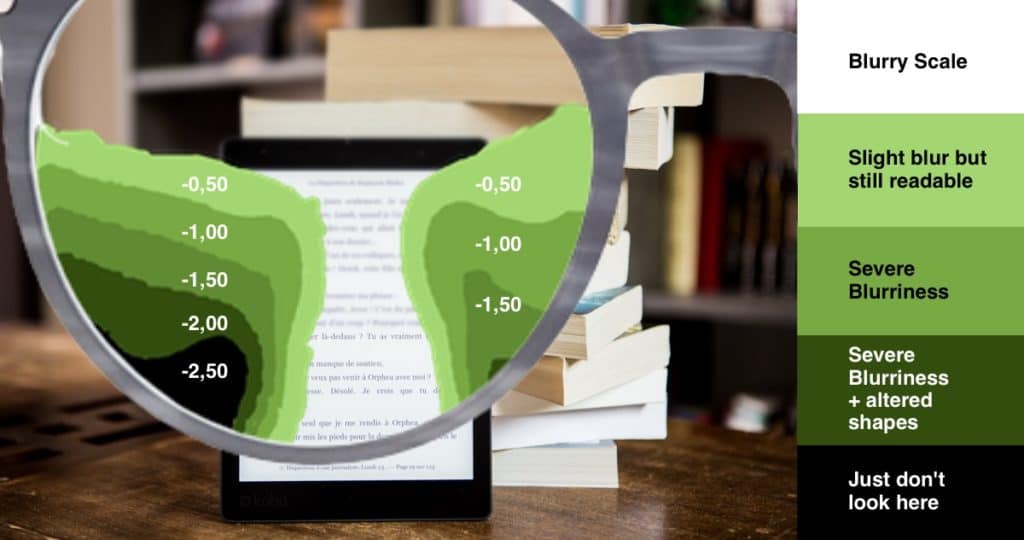The width of your field of view in progressive lenses is highly dependent on the Add value you need to read and what corridor length you choose (Short, Medium, or Long). These variables produce clear zones in your progressive lenses in the reading area from 2mm up to over 1cm.
You can get a better understanding if you have a closer look at the Minkwitz Theorem. It describes the relationship between the two mentioned options. The shorter the corridor length the less wide your clear field of view will be. And the more reading support you rely on the less clear field of view you will get.
However, the Minkwitz Theorem gives you just a hint on what to expect from your progressive lenses as your individual choice of model can vary in its design significantly in a part of the corridor from the Minkwitz Theorem. But on average this will give you realistic expectations.

You can have a quick look at this table below to see the result the Minkwitz theorem will give in regard to the clear field of view in your progressive lenses. The width of the reading zones got calculated here. Just combine the length of your progressive lenses with your needed ADD and you will get How Wide Is the Field of View in Progressive Lenses.
| ADD | Corridor length 12mm (Short) | Corridor length 15mm (Medium) | Corridor length 18mm (Long) |
| 0,75 | 8mm | 10mm | 12mm |
| 1,00 | 6mm | 7,5mm | 9mm |
| 1,25 | 4,8mm | 6mm | 7,2mm |
| 1,50 | 4mm | 5mm | 6mm |
| 1,75 | 3,43mm | 4,29mm | 5.14mm |
| 2,00 | 3mm | 3,75mm | 4,5mm |
| 2,25 | 2,67mm | 3,3mm | 4mm |
| 2,5 | 2,4mm | 3,0mm | 3,6mm |
| 2,75 | 2,18mm | 2,73mm | 3,2mm |
| 3,00 | 2mm | 2,5mm | 3mm |
If you want to know how wide the field of view will be in your progressive lenses you need to know the distance you want to read in and the distance from your lenses back surface to your eyes apex. Here I can tell you out of my experience the closer your eyes are to your lenses the wider your field of you will get. The same is true if you can increase the reading distance.
All the descriptions can be easily explained in this little illustration.

Just imagine the clear field of view is a keyhole and as you move closer to the (decrease distance from the eye to the lenses) hole you will have a bigger field of view. If you want to know exactly what to expect you could have a closer look at the table below.
Most people will have an Add value of 1,50D up to 2,50D in their progressive lenses and tend to read at a distance of approximately 40cm. That’s why I focused on the most common relations here in order to don´t blow this table up too much. The average vertex distance is 12mm.
I could have gone with the parameters of the formula to calculate your field of view in your progressive lenses but you can not measure them and I want to explain it in a very easy way what you can expect. So I stayed with the same table design from above.
| ADD | Corridor length 12mm (Short) | Corridor length 15mm (Short) | Corridor length 18mm (Short) |
| 1,50 | 1,72cm | 2,1cm | 2,5cm |
| 1,75 | 1,48cm | 1,8cm | 2,2cm |
| 2,00 | 1,29cm | 1,62cm | 1,93cm |
| 2,25 | 1,14cm | 1,44cm | 1,73cm |
| 2,50 | 1,04cm | 1,21cm | 1,56cm |
Shocked?! The reality is not quite that bad. Read on and learn why you get a little more clear field of view in your progressive lenses.
The clear field of view is restricted by surface astigmatisms. Those astigmatism blurs your view as you perform eye movements from left to right. They are inherent in every progressive lens and come with every supplier. You avoid this astigmatisms as you stay in the center of the reading zone.
However, as you move your eyes horizontally outside of the clear field of view you will notice a really subtle blur. You will be still able to read but the contrast is not what you are used to looking through the perfect spots.

As you move more and more into the periphery you will notice increasing astigmatism. One diopter of astigmatism decreases your visual acuity by 50%. Centered around the reading zone surface astigmatisms are there but a lot of people are not able to see those finest changes in vision. They only notice the blur more if they shift there eyes more into the periphery.
So you get a little more clear field of view out of the lenses. But people define the clear field very differently. Some will be able to read and accept an ever so slight blur. But if you expect to have 20/20 Vision or 100% visual acuity you might be surprised how small the width of your clear field of view really is. Especially when you get your next progressive lenses and the ADD value has increased.
You can actually see the clear fields as you move the lens in your hands and pay attention to the objects behind your glasses. You will see altered shapes and can therefore easily spot the zones to gauge how big your field of view is. Like in the picture below.

But don’t worry you won’t get so extremely altered shapes in your progressive lenses. These effects just gets way stronger the more you increase the distance from the glasses to your eyes.
So in short, I gave you some really detailed information here on how big your field of view probably will be. If you are new to progressive lenses and you are still not sure what to expect – think this way. Think about a newspaper you want to read. The clear field of view in your progressive lenses will give you the ability to see approximately two of the smaller columns in a newspaper perfectly.
If you want more field of view you need an additional pair of office glasses or reading glasses. Office glasses, by the way, are also progressive lenses. The reason why they allow you to make a way bigger eye movements from left to right is due to the fact of the combination of a lower ADD value compared to your normal progressive lenses in combination with a similar or even bigger corridor.
All this information here about how big your field of you will be in your progressives is only true if the centration of your lenses is perfect. For example, if you have an ADD value of 2,50D which is pretty common, and the lenses are decentered just by 1,5mm horizontally you will have a 50% smaller field of view compared to the chart [Source: Dieter Kalder]! If you have problems with your progressive lenses check out this article here.
I hope this article makes it a little easier for you to choose your next progressive lenses. If you liked this article shared it with your friends. I wish you a great day.
